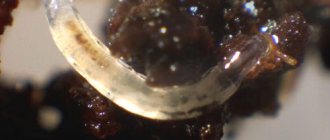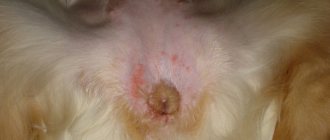Helminths cause enormous harm to the dog - they take away nutrients and vitamins, injure the walls of blood vessels, cause allergic reactions, and clog the intestinal lumen. There are no dogs free from parasites; however, the harmfulness of helminths manifests itself when their numbers exceed acceptable values. Having noticed that worms are crawling out of their dogs, animal owners give their pet strong medications and get severe intoxication. The main problem is that some types of helminths are dangerous to humans.
From the article you will learn the signs of wormism in dogs, what they look like and what types of worms there are. Optimal deworming regimen.
Why are worms dangerous for dogs?
Parasites in dogs are a common occurrence if prevention is ignored. The immune system of a healthy pet kills them up to a certain stage, but if there are too many parasites, it may not be able to cope. Dogs with weakened immune systems and puppies are also at risk.
Worms don't just live in the body. They parasitize on it, eating tissues and organs, as well as food from which the dog extracts nutrients. Result:
- decline in immunity;
- developmental delay in puppies;
- itching, pain, discomfort have a bad effect on the animal’s nervous system;
- tendency to various diseases;
- intoxication of the body, allergies provoked by waste products of worms.
Parasites cause diseases of the liver, lungs, heart, and brain. The dog may develop jaundice, intestinal obstruction, and blindness. Large individuals can clog a vessel and cause thrombosis, which will cause the death of the animal.
Are worms transmitted from dogs to people?
Whether a person becomes infected with worms depends on the parasite. Among them there are individuals that live only on dogs, and there are also those that can live in humans. Therefore, maintain hygiene - wash your hands with soap after each contact with an animal, do not let your pet on the bed, etc.
When can worms be seen in feces?
Note that the appearance of worms (especially whole lumps of them) in feces or vomit is not a good sign at all. As we have already said, during the course of evolution, their organisms have developed many useful adaptations that help parasites remain in the intestines. Accordingly, if their number grows to the maximum possible, some individuals may “fly” out.
But sometimes worms come out into the open of their own free will. Thus, in some species of round parasitic worms, females crawl out of the anus at night and lay eggs along its edges. In the case of cestodes, everything is even more dramatic. They cannot crawl out anywhere, but in these worms, individual segments of their body, the segments, are responsible for the spread of eggs.
They, being fully ripe, are sacs tightly stuffed with parasite eggs. Most often, the segments are thrown into the external environment along with feces, but in some species (in cucumber, for example, tapeworm), the segments can, after being separated from the body of the parasite, independently crawl out of the animal’s anus. During the movement, parasite eggs are abundantly released from special “nozzles” located on the sides of the segment.
Sometimes the segments can crawl really far; cases of their detection several meters from a peacefully sleeping dog have been described. It is for this reason that veterinarians strongly recommend carrying out high-quality wet cleaning in the room where the sick animal lived.
If the pet lived in an enclosure with a concrete floor, it is also washed with concentrated solutions of disinfectants. It is advisable to carry out the treatment twice, with an interval of three days. The plank floors are dismantled and carefully burned on both sides with a blowtorch fire. After this, the boards are also washed twice with solutions of disinfectants.
What does the appearance of worms in vomit indicate?
Considering that vomiting releases the contents of the stomach into the external environment, the appearance of worms there is a 100% bad sign.
And he points out two things at once:
- Firstly, there is a clear excess of parasites in the animal’s body.
- Secondly, the presence of parasites in the vomit indicates a very strong intoxication of the dog’s body. If the animal is not provided with qualified assistance in the near future, its kidneys and liver may suffer severe damage.
Why do worms rarely come out in feces after deworming?
Many dog breeders doubt the effectiveness of the antiparasitic treatment, since after deworming the feces turn out to be practically “clean”; worms are not present in them very often. What’s even more interesting is that this happens even with severe helminthic infestation. In fact, such a strange phenomenon can be easily explained.
It's all about the physiology of parasitic worms. In fact, they live in an extremely aggressive environment: digestive juice and enzymes are constantly released into the intestinal lumen. Worms are ordinary protein organisms, but their bodies are not digested in the dog’s gastrointestinal tract. This happens because the parasites’ body synthesizes special enzyme complexes that mask them from the gastrointestinal tract enzymes and the animal’s immune system . In addition, resistance to the action of digestive juices is explained by the special structure of the cuticle of their body, consisting of very “resistant” protein complexes.
Accordingly, dead worms are no longer able to synthesize these substances, after which the dog’s body begins to gradually digest their bodies. However, this process rarely reaches its logical conclusion. The proteins of parasites are too specific. The consequence of this is the appearance of abundant mucous impurities in the animal’s feces. They are the remains of half-digested parasites.
By the way, such a diet supplement is not very useful for the dog itself. Helminths contain a lot of toxic compounds, which, during the digestion of parasites, end up in the animal’s blood. This greatly increases the load on the pet’s entire excretory system. If the animal is old or weakened by illness, its liver or kidneys may not be able to handle it.
Ways of infecting dogs with worms
A dog experiences the world through its eyes, ears, and mouth. She often grabs unfamiliar objects on the street, drinks from puddles, sniffs/eats feces, foods (raw meat, fish, unwashed vegetables). Along with dirt and bacteria, worm eggs enter the body, become embedded in the intestines, and begin to grow and develop.
Parasites enter the body through the blood (hematogenous route), for example, through a mosquito or flea bite. The larvae enter the circulatory system and spread throughout the body.
Puppies can easily become infected in utero from their mother. Therefore, veterinarians recommend deworming for the first time a month, even if the puppy has not seen the street. You might be surprised at the size of worms that can come out of your baby.
What types do puppies have?
Puppies are susceptible to infection with the same helminths as adults; small dogs are especially likely to encounter roundworms - nematodes .
Often, the penetration of parasites into the puppy’s body occurs not only after birth, when the disease is caused by infected animals, objects or soil, but also while in the womb . For example, in the body of a pregnant female, activation of roundworm larvae can occur, which attack the embryos. As a result, the puppy becomes infected with worms even if the female has undergone anthelmintic treatment .
Types of worms in dogs
There are different types of worms, not all of them infect dogs. For example, some parasites typical of cats cannot be transmitted to dogs. There are also worms for which the dog is the definitive host, and for others it is a carrier. Having gone through a certain cycle in his body, the parasites are excreted in the feces and move on.
What do worms look like in a dog? Doctors identify 3 groups of worms that infect pets:
- Nematodes are round parasites. Among them are the pathogens of dirofilariasis (affect the heart), toxarosis (heart, liver, lungs), ascariasis (intestines, liver, gall bladder, esophagus).
- Cestodes are tapeworms, the largest parasites. They cause diphyllobothriasis (worm body up to 10 m), dipylidia (1.5 m), echinococcosis (0.5 m).
- Trematodes are flat helminths. Parasites attach to the lungs, liver, intestines, and pancreas. Trematodes feed on lymph, mucus, and blood. The most common diseases are paragonimiasis, alariasis, and opisthorchiasis.
Symptoms and signs of worms in dogs
Many pets appear clinically healthy, so owners are not worried. Important: the appearance of symptoms is a dangerous signal that indicates that the dog’s organs are seriously affected. Therefore, weak signs of even some of them are a reason to go to the doctor.
How to tell if your dog has worms: weight loss
A common symptom of helminthic infestation is sudden weight loss accompanied by increased appetite. Parasites take away from the dog elements of the substance that enter the body with food. The result is exhaustion of the animal.
Other symptoms
- Rumbling in the stomach due to an enlarged abdomen. The symptom is especially often caused by round parasites.
- Frequent vomiting, diarrhea.
- Mucus and blood in stool.
- Red spots on the stomach.
- Heavy shedding, dulling of fur.
- Suspicious movement in the stool.
- Itching in the perineum, anus, which is why the animal rides on its butt and licks itself.
- Pale mucous membranes of the eyes and mouth (anemia).
Dangerous symptoms
With toxocariasis, when worms become established in the gastrointestinal tract, the animal may refuse to eat. Cough, cramps, and digestive problems appear.
With dirofilariasis, which affects the heart and blood vessels, the following are observed:
- swelling of the paws;
- heart murmurs;
- itching;
- prostration;
- cough;
- bloating.
Heartworm is dangerous because it manifests itself too late, when the animal is difficult to save. Therefore, when they appear, immediately consult a doctor, otherwise the dog may die.
How to detect an infestation
Heartworms are very common and any dog can become infected. Therefore, every owner needs to know how to determine that a pet is sick. This will help you start treatment on time and prevent complications.
The difficulty is that many manifestations of helminthiasis are mild and resemble signs of other diseases, for example, poisoning or a cold. But there are several symptoms that require your dog to be seen by a veterinarian as soon as possible:
- changes in appetite, unnatural eating habits;
- hiccups, difficulty swallowing;
- itching of the anus, which manifests itself in the fact that the dog will ride on the floor on its butt;
- nausea, frequent vomiting, alternating constipation and diarrhea;
- the animal becomes lethargic, constantly lies down, does not want to play;
- the fur is tousled, dull, dandruff and bald patches may appear;
- feces with mucus, blood, sometimes you can notice worms or their larvae;
- the stomach is hard and swollen, although the pet looks thin;
- mucous membranes are pale;
- vitamin deficiency and anemia develop;
- allergic reactions;
- The pet's immunity decreases and he often gets sick.
If parasites have settled in a puppy, he will lag behind in development, grow poorly, and refuse food. He clearly has a bloated abdomen and discharge from his eyes and nose.
Diagnosis of helminthiasis
To find out which tablets to give your dog against worms, and to determine the degree and severity of the infection, you need to do the following:
- Fecal analysis, which shows whether dogs have worms and their type. Moreover, if worm eggs in dogs are detected quickly, it takes time to find out which worm has infected the animal.
- Blood analysis. Plasma testing determines antibodies, inflammatory processes and other pathologies that develop during helminthic infestation. With its help, the doctor finds out the extent of the damage, which helps prescribe treatment.
- Chest X-ray, ultrasound of the heart - the veterinarian prescribes if pulmonary or cardiac infection is suspected. X-ray and ultrasound will show the presence/extent of the lesion.
Worms in dogs: treatment
What to do if your dog has worms? Start treatment immediately. The doctor prescribes anthelmintic drugs based on the pathogen that has infected the body. If time is critical and the type of pathogen is unknown, universal remedies are prescribed (Alben, Helmintal, Pratel).
If the lungs, heart, or liver are severely damaged, the veterinarian will prescribe medications that will help restore their function and heal the wounds. These could be medications, injections, IVs.
In severe cases, surgery is resorted to. Removing heartworms from the heart and lungs is a dangerous procedure, but classical treatment can cause thrombosis and death of the animal at any time if the worm clogs an artery. The operation is carried out under ultrasound guidance to ensure that all worms are removed from the heart. After surgery, treatment is carried out under the supervision of a cardiologist.
How to give your dog medicine
How to treat worms in a dog, the veterinarian will tell you. Anthelmintic drugs are made in the form of tablets, less often - suspensions. They are usually given on an empty stomach, but if the pet does not tolerate the medicine well, it can be given after or during meals.
There are no deworming vaccinations for dogs. There are deworming drops for dogs on sale that also kill fleas and ticks, but their effectiveness is questionable. They will no longer become infected with flea mites. Therefore, it is better to give insect drops and worm tablets separately.
How to give a dog a suspension
The suspension can simply be squeezed into the animal's mouth (no more than a sip at a time). You can also draw the substance into a syringe by removing the needle, parting the dog’s lips and slowly squeezing it out. The pet will most likely refuse to swallow, so you need to prevent him from opening his mouth for 1-2 minutes. You can stroke your pet's throat to encourage him to swallow.
How to give a dog a pill
If a deworming tablet for dogs gives off the aroma of meat, the animal will happily eat it. If it has no taste or smell, the pet will refuse to swallow. In this case, do this:
- Using the thumb and index finger of one hand, open the dog's mouth.
- Quickly and carefully place the pill on the base of your tongue.
- Close the animal's mouth, hold it with your hands so that it does not open.
- Lift your pet's head up and stroke its throat to encourage swallowing movements.
- If the animal still does not swallow, gently blow into its nose. In this case, she will definitely take a sip.
- Praise your dog when he swallows the tablet.
Prevention of worms in dogs
To prevent infection, it is necessary to treat dogs for worms regularly, once a quarter. What to give your dog for worms? It is better to give preference to universal drugs that react to several types of worms. Before purchasing, read the instructions to make sure that the drug rarely causes side effects and belongs to the low-toxic class.
Give the tablet based on the weight of the animal. When deworming dogs, never give more than the recommended dose. The active substance of the drug circulates in the blood for a certain time, during which it will destroy not only adult individuals, but also worms that appeared after treatment.
Most drugs are designed for adult parasites; they rarely deal with eggs and larvae. If you doubt that the medicine will destroy eggs, read the instructions.
There are 2 types of deworming medications for dogs:
- Extended-life products that only need to be given once.
- Anti-worm medications for dogs, which must be given again 10-14 days after the first time. In this case, the product will eliminate the worms that hatched after the first treatment.
The best dewormers for dogs
Veterinarians recommend giving medications that are designed for different parasites. Many of them are expensive, and if you can't afford it, talk to your veterinarian about the best dewormers for dogs based on your budget.
The following deworming remedies have proven themselves to be effective:
- Helmintal, Milprazone, Pratel - cope with nematodes, cestodes;
- Endogard (Vinvark) – has a wide spectrum of action, effective against giardiasis and dirofilariasis;
- Alben - prescribed for pulmonary, gastrointestinal nematodes, cestodosis, trematodosis;
- Drontal – against three types of worms;
- Procox (Bayer) – from nematodes;
- Inspector – against nematodes, as well as parasites carried by fleas.
Folk remedies for worms in dogs
Do not try to treat your dog with folk remedies for worms. Many of them are not only useless, but also dangerous. For example, such popular remedies as onions and garlic can cause serious poisoning in your pet.
Heartworms
One of the most unpleasant and dangerous types of nematodes in dogs.
These are long (up to 40 cm) filamentous worms that live in the pulmonary artery and heart, and with a high degree of invasion they are found in the vena cava. The intermediate hosts (who carry the larvae) are mosquitoes, the final hosts are canines, because Only in their body can the parasite complete the full development cycle. The larvae grow and develop in the dog’s body for up to 250 days. Microfilariae (larvae) are carried by the bloodstream to all organs and tissues; they can live under the skin and in organs, provoking inflammation in these places. One of the first signs of worms (heartworms) in a dog is general malaise, as well as hemoptysis, shortness of breath, and exhaustion.
Heartworms can also settle in the human body, getting under the skin or in the eye; the larvae develop within 4-5 months. The full development cycle is not achieved, but its presence itself causes long-term dermatitis that is difficult to treat.
Veterinarian advice
Before you remove worms from your dog, do not forget to treat your pet for fleas. They are carriers of certain types of worms, and can infect the dog much earlier than the time for the next preventive treatment.
Worms and vaccination
Treatment for worms is a mandatory procedure before vaccination. Worms weaken the body, making it weak before infection. In addition, the work of the immune system when infected with worms will be aimed at destroying them. Therefore, antibodies to the vaccine may not be developed at all or in very small quantities.
It is necessary to remove worms from your dog before vaccination no less than 10 days before the injection. If you were given an antihistamine 1-1.5 months before vaccination, you do not need to give a tablet before vaccination.
Other veterinary advice
- To prevent infection with worms, give your dog only foods that have been heat-treated, or even better, super premium or holistic food.
- If you are a fan of a raw food diet, before giving your dog meat and fish, cut it into small (portioned) pieces and freeze for several days. In this case, preventive treatment will have to be carried out more often.
- Do not allow your animal to drink from puddles. She can not only become infected with worms, but also pick up a dangerous infection.
- When walking, wear a muzzle on your dog to prevent contact with feces, rotten food, and garbage. The accessory will also help avoid poisoning.
- Do not allow stray dogs near your pet. They can transmit fleas, worms, skin and other diseases to him.
- Buy anti-worm medications only from veterinary pharmacies and pet stores.
Relationship between helminth species and breed
It is mistakenly believed that only mongrel stray dogs living on the street can become infected with worms. The news that purebred dogs living in the apartment are also susceptible to the disease is met with surprise.
However, statistics claim that 60-80 percent of dogs kept in homes have parasitic worms of various types in their bodies .
This is due to the fact that for a dog to become infected with helminths, it is not necessary to wander the street and pick up garbage; contact with the shoes and clothes of the owners, which have been exposed to soil containing worm larvae, is sufficient.
Also, the dog owner himself can unwittingly infect his pet by feeding it poorly processed meat from infected farm animals .











